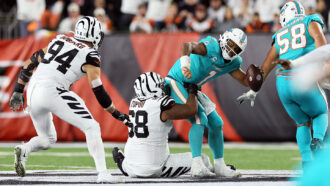In a football game on September 25, Miami Dolphins quarterback Tua Tagovailoa got the pass off but he got knocked down. Fans watched him shake his head and stumble to the ground as he tried to jog it off. After a medical check, he went back into the game against the Buffalo Bills with what his coach later said was a back injury.
Four days later, in a game against the Cincinnati Bengals, Tagovailoa, 24, got hit again. This time, he left the field on a stretcher with what was later diagnosed as a concussion.
Many observers suspect that the first hit — given Tagovailoa’s subsequent headshaking and wobbliness — left the athlete with a concussion, also called a mild traumatic brain injury. If those were indeed signs of a head injury, that first hit may have lined him up for an even worse brain injury just days later.
“The science tells us that yes, a person who is still recovering from a concussion is at an elevated risk for sustaining another concussion,” says Kristen Dams-O’Connor, a neuropsychologist and director of the Brain Injury Research Center at the Icahn School of Medicine at Mount Sinai in New York City. As one example, a concussion roughly doubled the chance of a second one among young Swedish men, researchers reported in 2013 in the British Medical Journal.
“This, I think, was avoidable,” Dams-O’Connor says of Tagovailoa’s brain injury in the game against the Bengals.
After a hit to the head, when the soft brain hits the unyielding skull, the injury kicks off a cascade of changes. Some nerve cells become overactive, inflammation sets in, and blood flow is altered. These downstream events in the brain — and how they relate to concussion symptoms — can happen over hours and days, and are not easy to quickly measure, Dams-O’Connor says.
That makes diagnosing a concussion tricky. Clinicians often have to rely on patients saying they feel off or fuzzy. Professional athletes might not be eager to share those symptoms if it means they’ll be sidelined. “These are elite athletes who are conditioned to suck it up,” Dams-O’Connor says.
Other signs can indicate a concussion, such as a person’s gait or pupil dilation. “As clinicians, we are often triangulating multiple sources of information to make that call — was this or was this not a concussion?” Dams-O’Connor says. The scientific uncertainty in that call should lead clinicians to err on the side of caution, she says.
After a traumatic brain injury, recuperation is crucial. “It’s much worse when an individual isn’t given the proper time to rest and recover and gets a second impact in a close period of time,” says Daniel Daneshvar, a brain injury medicine doctor and neuroscientist at Mass General Brigham in Boston and Harvard Medical School. Looking at the brains of mice after two close-together hits, researchers have seen signs of worse damage and a longer recovery (SN: 2/5/16).
For athletes, that vulnerability comes in part from concussion symptoms themselves. Slowed reaction times, dizziness and double vision confound a quick-moving quarterback who needs to dodge tackles and see opponents coming from the side. Those symptoms can lead to further injury to the head — and to the rest of the body. A concussion increases the risks of lower extremity injuries, according to a recent analysis of National Football League players published in August in Arthroscopy, Sports Medicine, and Rehabilitation.
What’s more, a healing brain is more susceptible to jarring. While the brain is still recovering in the weeks after an injury, “your threshold for getting a concussion is lower,” Daneshvar says. A lighter hit, researchers suspect, can do more damage. A rare condition called second impact syndrome illustrates an extreme outcome of successive brain injuries. This catastrophic, often fatal brain swelling happens when a still-healing brain is hit again.
That’s not what happened to Tagovailoa. But two concussions close together can delay recovery, Dams-O’Connor emphasizes. “I think people minimize how life-altering that can be.”
In a statement, the NFL and the NFL Players Association announced that they are jointly investigating whether their concussion protocols were followed in this case. Tagovailoa may have been allowed back into that first game because his stumbling was attributed — correctly or not — to a back injury, not a brain injury. The NFL and NFLPA are considering changing the protocol to keep a player out of a game for any obvious motor instability, regardless of cause.
For now, Tagovailoa is moving through the stages of recovery outlined in the concussion protocol. In a social media post on September 30, Tagovailoa thanked his team, friends and family and everyone who has reached out in support. “I’m feeling much better and focused on recovering so I can get back out on the field with my teammates,” he wrote.


